同济大学:《环境科学概论》课程教学资源(教案课件)Part 2 Water Resources and Treatment Topic 1 Water resources 水资源
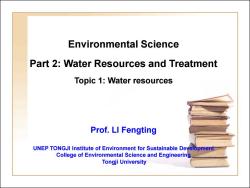
Environmental Science Part 2:Water Resources and Treatment Topic 1:Water resources Prof.LI Fengting UNEP TONGJI Institute of Environment for Sustainable Development College of Environmental Science and Engineering Tongji University
Environmental Science Part 2: Water Resources and Treatment Topic 1: Water resources Prof. LI Fengting UNEP TONGJI Institute of Environment for Sustainable Development College of Environmental Science and Engineering Tongji University
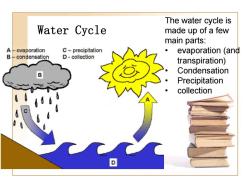
The water cycle is Water Cycle made up of a few main parts: A-evaporation C-precipitation evaporation (and B-condensation D-collection transpiration) Condensation Precipitation collection D
Water Cycle The water cycle is made up of a few main parts: • evaporation (and transpiration) • Condensation • Precipitation • collection
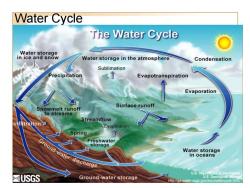
Water Cycle The Water Cycle Water storage in ice and snow Water storage in the atmosphere Condensation Sublimation Precipitation Evapotranspiration Evaporation Surface runoff Snowmelt runoff to streams Streamflow Evaporation Spring Ground-water discharge Freshwater storage Water storage in oceans U.S.Dopartmont of the Interio ≤USGS Ground-water storage U.S.Goological Suirve nttp://ga water.usgs.gov/edu/watercycle.html
Water Cycle
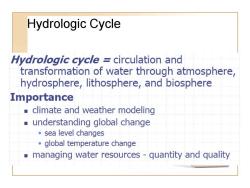
Hydrologic Cycle Hydrologic cycle circulation and transformation of water through atmosphere, hydrosphere,lithosphere,and biosphere Importance climate and weather modeling understanding global change ◆sea level changes global temperature change managing water resources-quantity and quality
Hydrologic Cycle
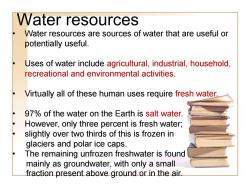
Water resources Water resources are sources of water that are useful or potentially useful. Uses of water include agricultural,industrial,household, recreational and environmental activities. Virtually all of these human uses require fresh water. 97%of the water on the Earth is salt water. ● However,only three percent is fresh water; slightly over two thirds of this is frozen in glaciers and polar ice caps. The remaining unfrozen freshwater is found mainly as groundwater,with only a small fraction present above ground or in the air
Water resources • Water resources are sources of water that are useful or potentially useful. • Uses of water include agricultural, industrial, household, recreational and environmental activities. • Virtually all of these human uses require fresh water. • 97% of the water on the Earth is salt water. • However, only three percent is fresh water; • slightly over two thirds of this is frozen in glaciers and polar ice caps. • The remaining unfrozen freshwater is found mainly as groundwater, with only a small fraction present above ground or in the air
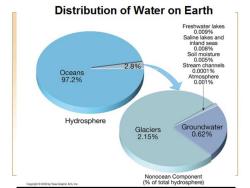
Distribution of Water on Earth Freshwater lakes 0.009% Saline lakes and inland seas 0.008% Soil moisture 0.005% 2.8% Stream channels Oceans 0.0001% 97.2% Atmosphere 0.001% Hydrosphere Glaciers Groundwater 2.15% 0.62% Nonocean Component opy002yTasraphc Arts inc. (of total hydrosphere)
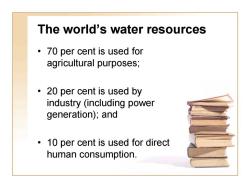
The world's water resources 70 per cent is used for agricultural purposes; 20 per cent is used by industry (including power generation);and 10 per cent is used for direct human consumption
The world’s water resources • 70 per cent is used for agricultural purposes; • 20 per cent is used by industry (including power generation); and • 10 per cent is used for direct human consumption
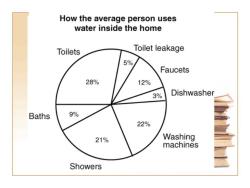
How the average person uses water inside the home Toilets Toilet leakage 5% Faucets 28% 12% 3% Dishwasher Baths 9% 22% 21% Washing machines Showers
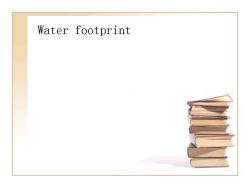
Water footprint
Water footprint
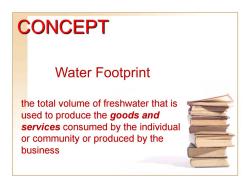
CONCEPT Water Footprint the total volume of freshwater that is used to produce the goods and services consumed by the individual or community or produced by the business
CONCEPT Water Footprint the total volume of freshwater that is used to produce the goods and services consumed by the individual or community or produced by the business
按次数下载不扣除下载券;
注册用户24小时内重复下载只扣除一次;
顺序:VIP每日次数-->可用次数-->下载券;
- 同济大学:《环境科学概论》课程教学资源(教案课件)来自水的挑战 Water Challenges in China.pdf
- 同济大学:《环境科学概论》课程教学资源(教案课件)概论 Environmental Science(负责人:李风亭).pdf
- 《环境科学概论》课程教学资源(文献资料)UNEP and UN-HABITAT——GREEN HILLS, BLUE CITIES AN ECOSYSTEMS APPROACH TO WATER RESOURCES MANAGEMENT FOR AFRICAN CITIES.pdf
- 《环境科学概论》课程教学资源(文献资料)Growing greenhouse gas emissions due to meat production.pdf
- 《水污染控制工程》课程教学资源(书籍资料)水污染治理先进技术汇编(科学技术部,2011年8月).pdf
- 广东海洋大学:环境资源系《遥感与地理信息系统》课程教学大纲.doc
- 广东海洋大学:环境资源系《生产布局原理》课程教学大纲.doc
- 广东海洋大学:环境资源系《环境质量评价》课程教学大纲.doc
- 广东海洋大学:环境资源系《环境生物学》课程教学大纲.doc
- 广东海洋大学:环境资源系《环境工程学》课程教学大纲.doc
- 广东海洋大学:环境资源系《环境土壤学》课程教学大纲.doc
- 广东海洋大学:环境资源系《测量学》课程教学大纲.doc
- 广东海洋大学:环境资源系《水土保持学》课程教学大纲.doc
- 广东海洋大学:环境资源系《植物营养学》课程教学大纲.doc
- 广东海洋大学:环境资源系《房地产开发与经营管理》课程教学大纲.doc
- 广东海洋大学:环境资源系《房地产市场学》课程教学大纲.doc
- 广东海洋大学:环境资源系《房地产估价》课程教学大纲.doc
- 广东海洋大学:环境资源系《应用测量学》课程教学大纲.doc
- 广东海洋大学:环境资源系《地质学基础》课程教学大纲.doc
- 广东海洋大学:环境资源系《地图编绘》课程教学大纲.doc
- 同济大学:《环境科学概论》课程教学资源(教案课件)固体废物1 Solid Waste Management(2)landfilling.pdf
- 同济大学:《环境科学概论》课程教学资源(教案课件)Part 2 Water Resources and Treatment Topic 3 Water and wastewater treatment 水处理.pdf
- 同济大学:《环境科学概论》课程教学资源(教案课件)Part 2 Water Resources and Treatment Topic 2 Water pollution 水污染.pdf
- 同济大学:《环境科学概论》课程教学资源(教案课件)固体废物2 Solid Waste Management(3)Incineration.pdf
- 同济大学:《环境科学概论》课程教学资源(教案课件)固体废物3 Solid waste management(4)composting.pdf
- 同济大学:《环境科学概论》课程教学资源(教案课件)大气 Fundamentals of Air Pollution Meteorology.pdf
- 同济大学:《环境科学概论》课程教学资源(教案课件)大气污染 Air and Air Pollution.pdf
- 中国人民大学:《环境管理体制分析》课程教学资源(教学大纲)Analysis of Environment Administration system.pdf
- 《环境管理体制分析》课程教学资源(文献资料)2011-2015年我国31个省能源使用情况数据统计.pdf
- 《环境管理体制分析》课程教学资源(文献资料)2012-2015年我国31个省用水情况数据统计.pdf
- 《环境管理体制分析》课程教学资源(文献资料)我们怎样喝到好水?.pdf
- 《环境管理体制分析》课程教学资源(文献资料)环境保护相关法律汇编.pdf
- 《环境管理体制分析》课程教学资源(文献资料)2011-2015年全国31个省SO2和COD排放数据(课程使用).pdf
- 《环境管理体制分析》课程教学资源(文献资料)生态文明体制改革总体方案.pdf
- 《环境管理体制分析》课程教学资源(文献资料)新形势下改革和加强中国环境保护管理体制的思考.pdf
- 《环境管理体制分析》课程教学资源(文献资料)基于GDP的中国资源环境基尼系数分析.pdf
- 《环境管理体制分析》课程教学资源(文献资料)论绿色发展理念下环境执法垂直管理体制的改革与构建.pdf
- 《环境管理体制分析》课程教学资源(文献资料)中国环境管理体制改革的回顾与反思.pdf
- 《环境管理体制分析》课程教学资源(文献资料)美国环境管理体制对中国的启示 Enlightenment of US environmental management system to China.pdf
- 《环境管理体制分析》课程教学资源(文献资料)我国环境管理体制改革思路探析.pdf
